Karakalpakistan |
|
|
|
| Übersicht – Contents: | |
Karakalpakistan |
|
|
|
| Übersicht – Contents: | |
Flagge – Flag: |
|
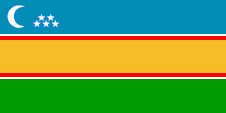 |
seit/since 1990, |
|
|
|
historische Flaggen – historical Flags: |
|
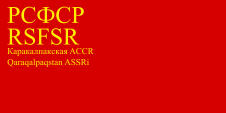 |
1934–1937, Flagge der Karakalpakischen ASSR – flag of the Karakalpakian ASSR, Seitenverhältnis – ratio = 1:2, Quelle/Source, nach/by: Flags of the World |
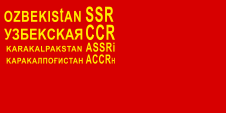 |
1937–1941, Flagge der Karakalpakischen ASSR – flag of the Karakalpakian ASSR, Seitenverhältnis – ratio = 1:2, Quelle/Source, nach/by: Flags of the World |
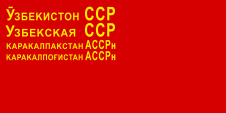 |
1941–1952, Flagge der Karakalpakischen ASSR – flag of the Karakalpakian ASSR, Seitenverhältnis – ratio = 1:2, Quelle/Source, nach/by: Flags of the World |
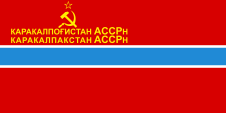 |
1952–1990, Flagge der Karakalpakischen ASSR – flag of the Karakalpakian ASSR, Seitenverhältnis – ratio = 1:2, Quelle/Source, nach/by: Flags of the World |
|
siehe auch – look also: Flaggengeschichte der Sowjetrepubliken der UdSSR – flag history of the soviet republics of the USSR |
|
|
|
|
|
|
|
Bedeutung/Ursprung der Flagge – Meaning/Origin of the Flag: |
|
| Die Gestaltung der Flagge Kakakalpakiens orientiert sich sehr an der Flagge Usbekistans, zu dem Karalapakien politisch gehört. Die Flagge Kakakalpakiens zeigt drei waagerechte Bahnen in Blau, Gelb und Grün, wobei der gelbe Mittelstreifen von schmalen rot-weißen Streifen begrenzt ist. Im blauen oberen Streifen sind ein weißer Halbmond und fünf weiße, fünfzackige Sterne zu sehen. Der Halbmond und die Farbe Grün stehen für den Islam, das Blau steht für das Wasser und den Himmel, und das Weiß für Frieden, Wohlstand und Harmonie. Grün symbolisiert Fruchtbarkeit und Landwirtschaft, und Gelb steht für das karakalpakische Volk. Die Farben werden Hexadezimal (RGB) angegeben mit Blau #008FB8, Rot #DB2017, Gelb #F7BE24, Grün #1A9D37, was CMYK entsprechen würde Blau 79|18|10|15, Rot 0|94|100|0, Gelb 0|27|93|0, Grün 80|0|100|5, was in Pantone entsprechen würde Blau 7460, Rot 1795, Gelb 7408, Grün 362. | The
design of the flag of Kakakalpakstan is greatly orientatet in the flag of
Uzbekistan, to which Kakakalpakstan politically belongs. The flag of
Kakakalpakstan shows three horizontal sripes in blue, yellow and green,
whereas the yellow middle stripe is bordered by narrow red-white stripes.
In the blue upper stripe are to recognize a white half-moon and five white five-pointed stars. The half-moon and the colour green stand for the Islam, the blue stands for the water and the heaven, and the white for peace, prosperity und harmony. Green symbolizes fertility and agriculture and yellow stands for the Karakalpakian people. The colours are given in hexadecimal (RGB) with Blue #008FB8, Red #DB2017, Yellow #F7BE24, Green #1A9D37, which would correspond to CMYK Blue 79|18|10|15, Red 0|94|100|0, Yellow 0|27|93|0, Green 80|0|100|5, which would correspond to Pantone Blue 7460, Red 1795, Yellow 7408, Green 362. |
| Quelle/Source: Wikipedia (D), Wikipedia (EN) | |
|
|
|
Wappen – Coat of Arms: |
|
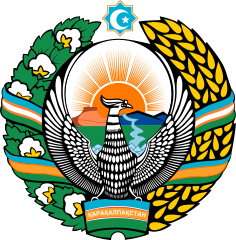 |
Wappen von Karakalpakistan – coat of arms of Karakalpakstan, Quelle/Source: File:Emblem_of_Uzbekistan.svg: VariousNikNaks talk - gallery - wikipedia, Public domain, via Wikimedia Commons |
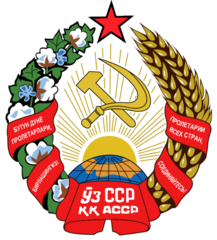 |
1978 (1937)–1993 Wappen der Karakalpakischen Autonomen Sozialistischen Sowjetrepublik – coat of arms of the Karakalpak Autonomous Soviet Socialist Republic, Quelle/Source: Jamshid Nurkulov, CC BY-SA 4.0, via Wikimedia Commons |
|
|
|
Bedeutung/Ursprung des Wappens – Meaning/Origin of the Coat of Arms: |
|
| Das heutige Wappen von Karakalpakstan wurde von Jollybai Izentaev geschaffen und am 09.04.1993 eingeführt. Es basiert auf dem Wappen von Usbekistan und zeigt die aufgehende Sonne, die alte zoroastrische Festung Chilpyk, den Fluss Amu Darya und den Aralsee. Es ist umgeben von einem Kranz aus Weizenähren und Baumwollzweigen. Ganz oben befindet sich ein blaues Oktaeder mit Halbmond und Stern in Weiß. Die Figur in der Mitte ist der mythische Kumai-Vogel. Das Spruchband in den Farben der Flagge zeigt den Landesnamen in kyrillischer Schrift: "KАРАKАЛПАKСТАН" ("QARAQALPAQSTAN"). |
The today's coat of arms
of Karakalpakstan was created by Jollybai Izentaev and was adopted on 9th of
April in 1993. It is based on the coat of arms of Uzbekistan and shows the
rising sun, the ancient Zoroastrian fortress of Chilpyk, the Amu Darya River
and the Aral Sea. It is surrounded by a wreath of wheat ears and cotton
branches. At the top is a blue octahedron with a crescent moon and star in white. The figure in the centre is the mythical Kumai bird. The banner in the colours of the flag shows the country's name in Cyrillic script: "KАРАKАЛПАKСТАН" ("QARAQALPAQSTAN"). |
| Quelle/Source: Wikipedia (EN) | |
|
|
|
Landkarte – Map: |
|
Lage von Karakalpakistan (mattrot) in Usbekistan – Location of Karakalpakistan (flat red) within Uzbekistan |
|
|
|
Zahlen und Fakten – Numbers and Facts: |
|
|
|
|
|
|
|
|
|
|
|
|
|
|
|
|
|
|
|
|
| 16. Jhd.
· das Turkvolk der Karakalpaken (übersetzt: "Schwarzmützen") siedelt am
Fluss Syrdaria, ca. 750 km von seinen heutigen Siedlungsgebieten entfernt 18. Jhd. · Vertreibung der Karakalpaken durch die Kasachen, Flucht in Richtung Westen, in die Gegend des Khanats Chiwa südlich des Aralsees, aber auch nach Süden, in den Bereich des Kahanats Kokand (Ferganatal) 1824–1853 · russische Eroberung Kasachstans 1865–1868 · russische Eroberung Usbekistans, Kirgisiens und des Khanates Kokand, Bildung des Generalgouvernements Turkestan 1868 · russische Eroberung des Khanates Buchara 1873 · russische Eroberung des Khanates Chiwa, damit kommen Teile des heutigen Karakalpakiens unter den Einfluss von Russland 1876 · die Khanate Buchara und Chiwa werden als russische Protektorate formell unabhängig 1922 · Errichtung der Sowjetdiktatur, das Khanat Chiwa wird "Choresmische Sowjetische Volksrepublik" 1924 · Zusammenfassung der Choresmischen Sowjetischen Volksrepublik und der Sozialistischen Volksrepublik Buchara zur Usbekischen Sozialistischen Sowjetrepublik (Usbekistan), Eingliederung in die Sowjetunion 1925 · Errichtung der Karakalpakischen Autonomen Provinz innerhalb Usbekistans 1932 · die Karakalpakische Autonome Provinz wird Karakalpakische Autonome Sozialistische Sowjetrepublik, jedoch Sowjetrussland (Russische Sozialistische Föderative Sowjetrepublik) angegliedert 1936 · die Karakalpakische Autonome Sozialistische Sowjetrepublik wird wieder der Usbekischen Sozialistischen Sowjetrepublik eingegliedert 1991 · Ausrufung der Autonomen Republik Karakalpakien (innerhalb Usbekistans) 2022 · Usbekistan überlegt Möglichkeiten der Einschränkung der Autonomie von Karakalpakistan über eine Verfassungsänderung, es kommt in Karakalpakistan zu Demonstrationen und Aufruhr mit mehreren Toten, am 02.07.2022 gibt Usbekistan bekannt, von der Verfassungsänderung abzusehen, die Lage beruhigt sich |
|
|
| 16th
cent. · the Turkish people of the Karakalpaks (translated: "black caps")
settles near the river Syrdaria, ca. 750 km far from its today's settlement
areas 18th cent. · expulsion of the Karakalpaks by the Kazakh, escape in western direction in the region of the Khanate of Khiwa southern the Aral Sea, but also in southern direction, in the region of the Khanate of Kokand (Fergana Valley) 1824–1853 · Russian conquest of Kazakhstan 1865–1868 · Russian conquest of Uzbekistan, Kyrgyzstan and of the Khanate of Kokand, establishment of the des General Government of Turkestan 1868 · Russian conquest of the Khanate of Bukhara 1873 · Russian conquest of the Khanate of Chiwa, in this way come parts of the today's Karakalpakstan under influence of Russia 1876 · the Khanates of Bukhara and Khiwa become formally independent as Russian protectorates 1922 · establishment of the Soviet Dictatorship, the Khanate of Khiwa becomes "Khoresmian Soviet People's Republic" 1924 · summary of the Khoresmian Soviet People's Republic and the Socialistic People's Republic of Bukhara to the Uzbek Socialistic Soviet Republic (Uzbekistan), incorporation into the Soviet Union 1925 · establishment of the Karakalpakian Autonomous Province within Uzbekistan 1932 · the Karakalpakian Autonomous Province becomes Karakalpakian Autonomous Socialistic Soviet Republic, but incorporated into Soviet Russia (Russian Socialistic Federative Soviet Republic) 1936 · the Karakalpakian Autonomous Socialistic Soviet Republic gets incorporated back into the Uzbek Socialistic Soviet Republic 1991 · proclamation of the Autonomous Republic of Karakalpakstan (within Uzbekistan) 2022 · Uzbekistan considers the possibility of limiting the autonomy of Karakalpakstan by amending the constitution; demonstrations and riots break out in Karakalpakstan with several deaths; on 2nd of July in 2022 Uzbekistan announces that it will refrain from amending the constitution; the situation calms down |
| Quelle/Source: Wikipedia (D), World Statesmen |
|
|
Ursprung des Landesnamens – Origin of the Country's Name: |
|
| Der Name des Landes das geht auf das hier seit dem 18. Jahrhundert lebende Turkvolk der Karakalpaken zurück. Der Name des Volkes heißt übersetzt "Schwarzmützen". | The name of the country goes back to the Turk people of the Karakalpaks, who have lived here since the 18th century. The name of the people is to translate as "black hats". |
| Quelle/Source: Volker Preuß | |
|
|
|